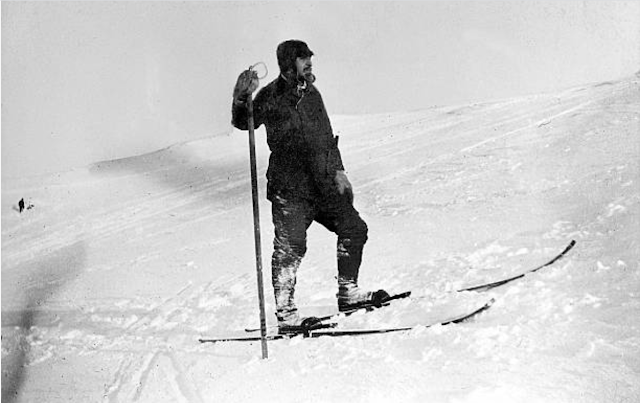Until I came across this photo last week, I had assumed that the first typewriters taken to Antarctica were Remingtons used during British Lieutenant Ernest Shackleton’s 1908-09 expedition. But here is evidence that French scientist and explorer Jean-Baptiste-Étienne-Auguste Charcot (1867-1936) used a Remington on his ship, the three-masted Le Français, during his 1903-07 expedition. The photo was taken by Charcot’s friend, the industrialist Paul Pléneau.
Charcot was born in Neuilly-sur-Seine, the son of the founder of modern neurology Jean-Martin Charcot (1825–1893), an important influence on Sigmund Freud. Jean-Baptiste Charcot was the winner of two sailing silver medals at the 1900 Paris Olympic Games, crewing for François Texier in the two finals for boats up to half a ton, raced on the Seine in Meulan-en-Yvelines in the third week of May. His polar ship was built in Saint-Malo in 1903.
In later life Charcot explored Rockall (a desolate island of which I’ve written on this blog) in 1921 and Eastern Greenland and Svalbard from 1925 until 1936. He died when Pourquoi-Pas? was wrecked in a storm off the coast of Iceland in 1936.
Shackleton’s 1908-09 expedition began on New Year’s Day, 1908, when the Nimrod
set off on the British Antarctic Expedition from Lyttelton Harbour, New Zealand,
and arrived at the eastern sector of the Great Ice Barrier on January 21. Shackleton
sailed on to McMurdo Sound, arriving there on January 29, with a base eventually
being established at Cape Royds. It took almost a full year, until January 9, 1909,
for Shackleton and three companions to reach a new Farthest South latitude of
88° 23' S, a point only 112 miles from the South Pole. They became the first people
to see and travel on the South Polar Plateau. Their return journey to McMurdo
Sound was a race against starvation, on half-rations for much of the way. The
expedition's other main accomplishments included the first ascent of Mount
Erebus, and the discovery of the approximate location of the South Magnetic
Pole, reached on January 16, 1909.
Photos of typewriter use in Antarctica were taken of assistant biologist Apsley Cherry-Garrard by Herbert Ponting on Captain Robert Scott's ill-fated Terra Nova expedition of 1910-12. Scott’s march south toward the South Pole began on November 1, 1911, a few months after these photos were taken. Scott reached the Pole on January 11, 1912, only to find he’d been beaten there by Norwegian Roald Amundsen.
Australian Frank Hurley's remarkable photographs of Shackleton's disastrous 1914-17 expedition include one showing a Yost typewriter in Shackleton’s cabin on the Endurance.
Mention of Cape Royds finally brings me to this photo of Geoffrey Lee-Martin, my chief-of-staff on The New Zealand Herald when I worked in Auckland in the late 1960s. Lee-Martin is typing a story on his Empire Aristocrat portable typewriter at Cape Royds, which forms the west extremity of Ross Island, facing on to McMurdo Sound, in January 1956, when he was covering Sir Edmund Hillary's Commonwealth Trans-Antarctic Expedition.









Morning Robert:
ReplyDeleteAgain a great blog for all of use armchair travellers.
Thanks,
John
I wonder how laptops do in Antarctica. Probably not as well as Remingtons!
ReplyDeleteThe photos seem to prove a manual typewriter works anywhere in the world.
ReplyDeleteCherry-Garrard's memoir of the Scott expedition, The Worst Journey in the World, is a masterpiece. I'm delighted by the picture of him and the Underwood.
ReplyDeleteMany thanks for again a very enjoyable read - the image of the French explorers in 1904 is magnificent. How very French, set out the bistro-set and pop open a bottle of champagne :-)
ReplyDeleteI am amazed by the fact how well typewriters resist extreme coldness... <3
ReplyDeleteHi Robert,
ReplyDeleteI came across your first photo this morning (actually as a Remington adverting postcard published in France...)
I was just willing to add a rugby connection here : Jean Baptiste CHARCOT won French rugby championship in 1896 with OLYMPIQUE, an ephemeral (and elitist...) spin-ff from Racing Club de France. Here he stands, 2nd from the left https://www.flickr.com/gp/rugby_pioneers/3tod7R
@+
As I was giving a second read to your excellent post, I’ve found another far-fetched rugby connection… Cape Royds is named after Charles Royds, the young brother of Admiral Sir Percy Royds of rugby fame ;)
ReplyDelete